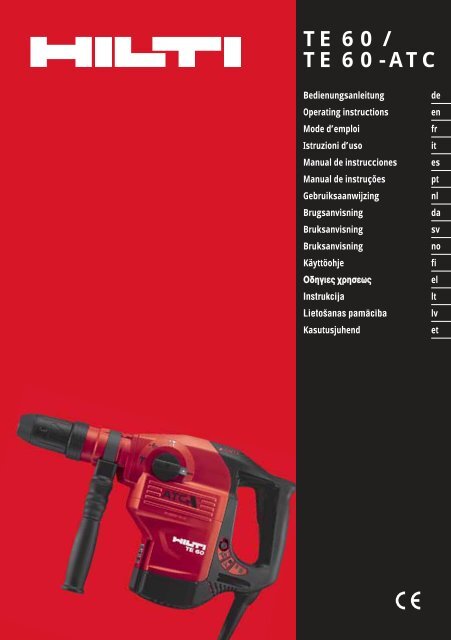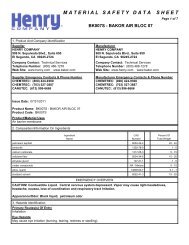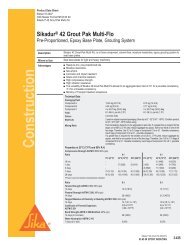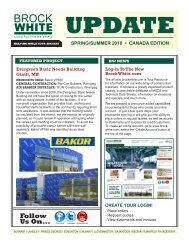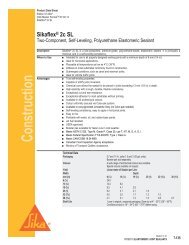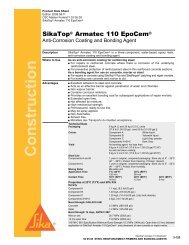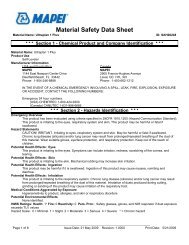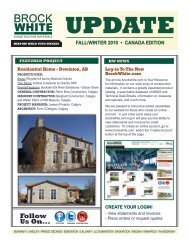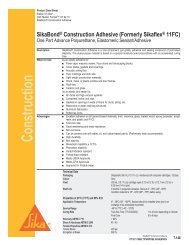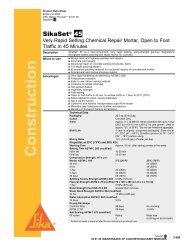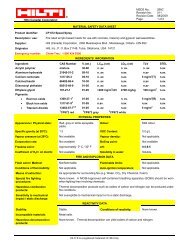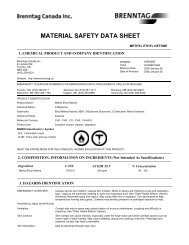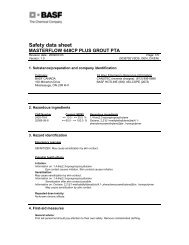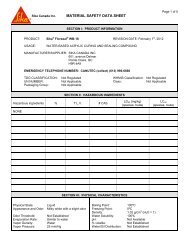Create successful ePaper yourself
Turn your PDF publications into a flip-book with our unique Google optimized e-Paper software.
<strong>TE</strong> <strong>60</strong> /<br />
<strong>TE</strong> <strong>60</strong>-<strong>ATC</strong><br />
Bedienungsanleitung<br />
Operating instructions<br />
Mode d’emploi<br />
Istruzioni d’uso<br />
Manual de instrucciones<br />
Manual de instruções<br />
Gebruiksaanwijzing<br />
Brugsanvisning<br />
Bruksanvisning<br />
Bruksanvisning<br />
Käyttöohje<br />
Οδηγιες χρησεως<br />
Instrukcija<br />
Lietoßanas pamåcîba<br />
Kasutusjuhend<br />
de<br />
en<br />
fr<br />
it<br />
es<br />
pt<br />
nl<br />
da<br />
sv<br />
no<br />
fi<br />
el<br />
lt<br />
lv<br />
et
2 3<br />
4 5<br />
6 7<br />
8
ORIGINAL OPERATING INSTRUCTIONS<br />
<strong>TE</strong> <strong>60</strong> / <strong>TE</strong> <strong>60</strong>‐<strong>ATC</strong> / <strong>TE</strong> <strong>60</strong>T / <strong>TE</strong> <strong>60</strong>T‐<strong>ATC</strong><br />
combihammer<br />
It is essential that the operating instructions<br />
are read before the power tool is operated<br />
for the first time.<br />
Always keep these operating instructions<br />
together with the power tool.<br />
Ensure that the operating instructions are<br />
with the power tool when it is given to other<br />
persons.<br />
Contents<br />
Page<br />
1. General information 17<br />
2. Description 18<br />
3. Insert tools, accessories 20<br />
4. Technical data 21<br />
5. Safety instructions 23<br />
6. Before use 25<br />
7. Operation 26<br />
8. Care and maintenance 28<br />
9. Troubleshooting 29<br />
10. Disposal 30<br />
11. Manufacturer’s warranty - tools 31<br />
12. EC declaration of conformity 31<br />
1 These numbers refer to the corresponding illustrations.<br />
The illustrations can be found on the fold-out<br />
cover pages. Keep these pages open while studying<br />
the operating instructions.<br />
In these operating instructions, the designation “the<br />
power tool” always refers to the <strong>TE</strong> <strong>60</strong> / <strong>TE</strong> <strong>60</strong>-<strong>ATC</strong> /<br />
<strong>TE</strong> <strong>60</strong>T / <strong>TE</strong> <strong>60</strong>T-<strong>ATC</strong> combihammer.<br />
Parts, operating controls and indicators 1<br />
@ Chuck<br />
; Function selector switch<br />
= Control switch<br />
% Supply cord<br />
& Side handle<br />
( Depth gauge<br />
) Service indicator<br />
+ Theft protection indicator (option)<br />
§ Control switch lock<br />
/ Reduced-power indicator<br />
: Power reduction button (50% power)<br />
en<br />
1. General information<br />
1.1 Safety notices and their meaning<br />
DANGER<br />
Draws attention to imminent danger that could lead<br />
to serious bodily injury or fatality.<br />
WARNING<br />
Draws attention to a potentially dangerous situation<br />
that could lead to serious personal injury or fatality.<br />
NO<strong>TE</strong><br />
Draws attention to an instruction or other useful<br />
information.<br />
1.2 Explanation of the pictograms and other<br />
information<br />
Warning signs<br />
CAUTION<br />
Draws attention to a potentially dangerous situation<br />
that could lead to slight personal injury or damage to<br />
the equipment or other property.<br />
General<br />
warning<br />
Warning:<br />
electricity<br />
Warning: hot<br />
surface<br />
17
Obligation signs<br />
en<br />
Wear eye<br />
protection<br />
Wear a hard<br />
hat<br />
Wear ear<br />
protection<br />
Wear<br />
protective<br />
gloves<br />
Watts<br />
Alternating<br />
current<br />
Hertz<br />
Rated speed<br />
under no load<br />
Wear<br />
breathing<br />
protection<br />
Revolutions<br />
per minute<br />
Diameter<br />
Double<br />
insulated<br />
Equipped with<br />
theft<br />
protection<br />
system<br />
Symbols<br />
Lock symbol<br />
Read the<br />
operating<br />
instructions<br />
before use<br />
Return waste<br />
material for<br />
recycling.<br />
Drilling<br />
without<br />
hammering<br />
Hammer<br />
drilling<br />
Location of identification data on the power tool<br />
The type designation can be found on the type identification<br />
plate and the serial number on the side of<br />
the motor housing. Make a note of this data in your<br />
operating instructions and always refer to it when<br />
making an enquiry to your Hilti representative or<br />
service department.<br />
Chiseling<br />
Chisel position<br />
adjustment<br />
Volts<br />
Amps<br />
Type:<br />
Generation: 02<br />
Serial no.:<br />
2. Description<br />
2.1 Use of the product as directed<br />
The power tool is an electrically-powered combihammer with pneumatic hammering mechanism. The <strong>ATC</strong><br />
(Active Torque Control) function of the <strong>TE</strong> <strong>60</strong>-<strong>ATC</strong> / <strong>TE</strong> <strong>60</strong>T‐<strong>ATC</strong> provides greater operating comfort while<br />
drilling.<br />
The tool is designed for drilling in concrete, masonry, metal and wood and can also be used for chiseling.<br />
The power tool is equipped with electronic overload protection. If the power tool is overloaded for a continuous<br />
period, motor speed will be reduced automatically and, if necessary, the motor may be stopped completely.<br />
When the control switch is released and then pressed again, the motor immediately regains full power. When<br />
restarting, care should thus be taken to ensure that the power tool is held securely with both hands.<br />
Under certain conditions, the power tool is suitable for use for mixing (see “Tools, accessories” and<br />
“Operation”).<br />
The power tool is designed for professional use and may be operated, serviced and maintained only by trained,<br />
authorized personnel. This personnel must be informed of any special hazards that may be encountered. The<br />
power tool and its ancillary equipment may present hazards when used incorrectly by untrained personnel or<br />
when used not as directed.<br />
18
Working on materials hazardous to the health (e.g. asbestos) is not permissible.<br />
The working environment may be as follows: construction site, workshop, renovation, conversion or new<br />
construction.<br />
The power tool may be used only in a dry environment.<br />
Take the influences of the surrounding area into account. Do not use the power tool where there is a risk of<br />
fire or explosion.<br />
The power tool may be operated only when connected to a power supply providing a voltage and frequency in<br />
compliance with the information given on its type identification plate.<br />
Observe the information printed in the operating instructions concerning operation, care and maintenance.<br />
To avoid the risk of injury, use only genuine Hilti accessories and insert tools.<br />
Modification of the power tool or tampering with its parts is not permissible.<br />
en<br />
2.2 Chuck<br />
<strong>TE</strong>‐Y (SDS-max) quick-change “click” chuck (<strong>TE</strong> <strong>60</strong> / <strong>TE</strong> <strong>60</strong>‐<strong>ATC</strong>)<br />
<strong>TE</strong>‐T (SDS-top) quick-change “click” chuck (<strong>TE</strong> <strong>60</strong>T / <strong>TE</strong> <strong>60</strong>T‐<strong>ATC</strong>)<br />
2.3 Switches<br />
Speed-control switch for smooth hole-starting / chiseling<br />
Function selector switch: Hammer drilling, rotary-only drilling, chiseling, chisel blade position (24-way<br />
adjustment)<br />
Choice of full or reduced (50%) power<br />
Control switch lockable for chiseling<br />
2.4 Grips<br />
Vibration-absorbing, pivotable side handle<br />
Vibration-absorbing grip<br />
2.5 Protective devices<br />
Mechanical safety clutch<br />
Electronic restart interlock to prevent the power tool starting unintentionally after an interruption in the electric<br />
supply (see section “Troubleshooting”).<br />
<strong>ATC</strong> Active Torque Control (<strong>TE</strong> <strong>60</strong>‐<strong>ATC</strong> / <strong>TE</strong> <strong>60</strong>T‐<strong>ATC</strong>)<br />
2.6 Lubrication<br />
Gearing and hammering mechanism with separate lubrication chambers<br />
2.7 Active Vibration Reduction<br />
The power tool is equipped with an AVR Active Vibration Reduction system which reduces vibration significantly<br />
compared to power tools without AVR.<br />
2.8 TPS Theft Protection System (optional)<br />
The power tool may be equipped with the TPS Theft Protection System as an option. If the power tool<br />
is equipped with this feature, it can be unlocked and made ready for operation only through use of the<br />
corresponding TPS key.<br />
2.9 LED indicators<br />
Service indicator LED (see section “Care and maintenance / service indicator”)<br />
Theft protection system indicator (optional) (see section “Operation / TPS theft protection system (optional)”)<br />
19
Reduced (50%) power indicator (see section “Operation / hammer drilling / chiseling”)<br />
en<br />
2.10 Items supplied as standard<br />
1 Power tool with side handle<br />
1 Depth gauge<br />
1 Grease<br />
1 Cleaning cloth<br />
1 Operating instructions<br />
1 Hilti toolbox<br />
2.11 Using extension cords<br />
Use only extension cords of a type approved for the application and with conductors of adequate cross section.<br />
The power tool may otherwise lose performance and the extension cord may overheat. Check the extension<br />
cord for damage at regular intervals. Replace damaged extension cords.<br />
Recommended minimum conductor cross section and max. cable lengths<br />
Conductor cross section 1.5 mm² 2mm² 2.5 mm² 3.5 mm²<br />
Mains voltage 100V 30 m 50 m<br />
Mains voltage 110-120 V 20 m 30 m 40 m<br />
Mains voltage 220-240 V 30 m 75 m<br />
Do not use extension cords with 1.25 mm² conductor cross section.<br />
2.12 Using extension cords outdoors<br />
When working outdoors, use only extension cords that are approved and correspondingly marked for this<br />
application.<br />
2.13 Using a generator or transformer<br />
This power tool may be powered by a generator or transformer when the following conditions are fulfilled:<br />
The unit must provide a power output in watts of at least twice the value printed on the type identification<br />
plate on the power tool. The operating voltage must remain within +5% and -15% of the rated voltage at all<br />
times, frequency must be in the 50 – <strong>60</strong> Hz range and never above 65 Hz, and the unit must be equipped with<br />
automatic voltage regulation and starting boost.<br />
Never operate other power tools or appliances from the generator or transformer at the same time. Switching<br />
other power tools or appliances on and off may cause undervoltage and / or overvoltage peaks, resulting in<br />
damage to the power tool.<br />
3. Insert tools, accessories<br />
Hammer drill bits <strong>TE</strong> <strong>60</strong> / <strong>TE</strong> <strong>60</strong>‐<strong>ATC</strong> Ø 12…40 mm<br />
Hammer drill bits <strong>TE</strong> <strong>60</strong>T / <strong>TE</strong> <strong>60</strong>T‐<strong>ATC</strong> Ø 6…32 mm<br />
Breach bits <strong>TE</strong> <strong>60</strong> / <strong>TE</strong> <strong>60</strong>‐<strong>ATC</strong> Ø 40…66 mm<br />
Breach bits <strong>TE</strong> <strong>60</strong>T / <strong>TE</strong> <strong>60</strong>T‐<strong>ATC</strong> Ø 40 mm<br />
Percussion core bits <strong>TE</strong> <strong>60</strong> / <strong>TE</strong> <strong>60</strong>‐<strong>ATC</strong> Ø 45…90 mm<br />
Percussion core bits <strong>TE</strong> <strong>60</strong>T / <strong>TE</strong> <strong>60</strong>T‐<strong>ATC</strong> Ø 50…90 mm<br />
PCM diamond core bits <strong>TE</strong> <strong>60</strong>‐<strong>ATC</strong> / <strong>TE</strong> <strong>60</strong>T‐<strong>ATC</strong> Ø 42…82 mm<br />
20
Chisels <strong>TE</strong> <strong>60</strong> / <strong>TE</strong> <strong>60</strong>‐<strong>ATC</strong> Pointed, flat and shaped chisels<br />
with <strong>TE</strong>‐Y connection end<br />
Chisels <strong>TE</strong> <strong>60</strong>T / <strong>TE</strong> <strong>60</strong>T‐<strong>ATC</strong> Pointed, flat and shaped chisels<br />
with <strong>TE</strong>‐T connection end<br />
Wood drill bits<br />
Ø 10…32 mm<br />
Metal drill bits<br />
Ø Max. 20 mm<br />
Side handle, complete 330083<br />
Depth gauge, complete 366482<br />
Anchor-setting tools <strong>TE</strong> <strong>60</strong> / <strong>TE</strong> <strong>60</strong>‐<strong>ATC</strong> Setting tools with <strong>TE</strong>‐Y connection<br />
end<br />
Anchor-setting tools <strong>TE</strong> <strong>60</strong>T / <strong>TE</strong> <strong>60</strong>T‐<strong>ATC</strong> Anchor-setting tools with <strong>TE</strong>‐T<br />
connection end<br />
TPS theft protection system with company card, company remote and Option, 206999<br />
TPS‐K key<br />
Quick-release chuck<br />
For wood and metal drill bits with<br />
smooth or hex. shank<br />
Mixing paddles for non-flammable materials, with smooth or hex. Ø 80…120 mm<br />
shank<br />
Dust removal system<br />
<strong>TE</strong> DRS‐S<br />
AVR ‐ Active Vibration Reduction<br />
<strong>ATC</strong> ‐ Active Torque Control<br />
en<br />
4. Technical data<br />
Right of technical changes reserved.<br />
NO<strong>TE</strong><br />
The power tool is available in various voltage ratings. Please refer to the type identification plate for details of<br />
the power tool’s voltage and power rating.<br />
Power tool<br />
Rated power<br />
Rated voltage / rated current<br />
Mains frequency<br />
Weight in accordance with EPTA procedure 01/2003<br />
(<strong>TE</strong> <strong>60</strong> / <strong>TE</strong> <strong>60</strong>T)<br />
Weight in accordance with EPTA procedure 01/2003<br />
(<strong>TE</strong> <strong>60</strong>-<strong>ATC</strong> / <strong>TE</strong> <strong>60</strong>T-<strong>ATC</strong>)<br />
Dimensions (L x W x H) <strong>TE</strong> <strong>60</strong><br />
Dimensions (L x W x H) <strong>TE</strong> <strong>60</strong>‐<strong>ATC</strong><br />
Dimensions (L x W x H), <strong>TE</strong> <strong>60</strong>T<br />
Dimensions (L x W x H), <strong>TE</strong> <strong>60</strong>T‐<strong>ATC</strong><br />
<strong>TE</strong> <strong>60</strong> / <strong>TE</strong> <strong>60</strong>‐<strong>ATC</strong> / <strong>TE</strong> <strong>60</strong>T / <strong>TE</strong> <strong>60</strong>T‐<strong>ATC</strong><br />
1,200 W<br />
Rated voltage 100 V: 15.0 A<br />
Rated voltage 110 V: 13.0 A<br />
Rated voltage 220 V: 6.8 A<br />
Rated voltage 230 V: 7.0 A<br />
Rated voltage 240 V: 7.2 A<br />
50…<strong>60</strong> Hz<br />
6.3 kg<br />
7.4 kg<br />
483 mm x 98 mm x 245 mm<br />
483 mm x 98 mm x 284 mm<br />
477 mm x 98 mm x 245 mm<br />
477 mm x 98 mm x 284 mm<br />
21
en<br />
Power tool<br />
<strong>TE</strong> <strong>60</strong> / <strong>TE</strong> <strong>60</strong>‐<strong>ATC</strong> / <strong>TE</strong> <strong>60</strong>T / <strong>TE</strong> <strong>60</strong>T‐<strong>ATC</strong><br />
Hammer drilling speed<br />
485/min<br />
Drilling speed without hammering<br />
695/min<br />
Single impact energy (50% power)<br />
3.5 J<br />
Single impact energy (full power)<br />
7.0 J<br />
Other information about the power tool<br />
Chuck (<strong>TE</strong> <strong>60</strong> / <strong>TE</strong> <strong>60</strong>‐<strong>ATC</strong>)<br />
<strong>TE</strong>‐Y<br />
Chuck (<strong>TE</strong> <strong>60</strong>T / <strong>TE</strong> <strong>60</strong>T‐<strong>ATC</strong>)<br />
<strong>TE</strong>‐T<br />
Protection class as per EN<br />
Protection class II (double insulated)<br />
NO<strong>TE</strong><br />
The vibration emission level given in this information sheet has been measured in accordance with a<br />
standardised test given in EN <strong>60</strong>745 and may be used to compare one tool with another. It may be used for a<br />
preliminary assessment of exposure. The declared vibration emission level represents the main applications of<br />
the tool. However if the tool is used for different applications, with different accessories or poorly maintained,<br />
the vibration emission may differ. This may significantly increase the exposure level over the total working<br />
period. An estimation of the level of exposure to vibration should also take into account the times when the<br />
tool is switched off or when it is running but not actually doing the job. This may significantly reduce the<br />
exposure level over the total working period. Identify additional safety measures to protect the operator from<br />
the effects of vibration such as: maintain the tool and the accessories, keep the hands warm, organisation of<br />
work patterns.<br />
Noise and vibration information (measured in accordance with EN <strong>60</strong>745‐2‐6):<br />
Typical A‐weighted sound power level (<strong>TE</strong> <strong>60</strong> / 110 dB (A)<br />
<strong>TE</strong> <strong>60</strong>T with <strong>ATC</strong> and AVR)<br />
Typical A‐weighted sound power level (<strong>TE</strong> <strong>60</strong> 107 dB (A)<br />
/ <strong>TE</strong> <strong>60</strong>T)<br />
Typical A‐weighted emission sound pressure level 99 dB (A)<br />
(<strong>TE</strong> <strong>60</strong> / <strong>TE</strong> <strong>60</strong>T with <strong>ATC</strong> and AVR)<br />
Typical A‐weighted sound pressure level (<strong>TE</strong> <strong>60</strong> 96 dB (A)<br />
/ <strong>TE</strong> <strong>60</strong>T)<br />
Uncertainty for the given sound level<br />
3 dB (A)<br />
Triaxial vibration values (<strong>TE</strong> <strong>60</strong> / <strong>TE</strong> <strong>60</strong>T with <strong>ATC</strong> and AVR, vibration vector sum)<br />
Hammer drilling in concrete, a h, HD<br />
9 m/s²<br />
Chiseling, a h, Cheq<br />
8.5 m/s²<br />
Uncertainty (K) for triaxial vibration value<br />
1.5 m/s²<br />
Triaxial vibration value for the <strong>TE</strong> <strong>60</strong> (vibration vector sum)<br />
Hammer drilling in concrete, a h, HD<br />
18.5 m/s²<br />
Chiseling, a h, Cheq<br />
14 m/s²<br />
Uncertainty (K) for triaxial vibration value<br />
1.5 m/s²<br />
Triaxial vibration values (<strong>TE</strong> <strong>60</strong>T, vibration vector sum)<br />
Hammer drilling in concrete, a h, HD<br />
18.5 m/s²<br />
Chiseling, a h, Cheq<br />
17 m/s²<br />
Uncertainty (K) for triaxial vibration value<br />
1.5 m/s²<br />
22
5. Safety instructions<br />
5.1 General power tool safety warnings<br />
WARNING! Read all safety warnings and all instructions.<br />
Failure to follow the warnings and instructions<br />
may result in electric shock, fire and/or serious injury.<br />
Save all warnings and instructions for future<br />
reference. The term “power tool” in the warnings<br />
refers to your mains-operated (corded) power tool or<br />
battery-operated (cordless) power tool.<br />
5.1.1 Work area safety<br />
a) Keep work area clean and well lit. Cluttered or<br />
dark areas invite accidents.<br />
b) Do not operate power tools in explosive atmospheres,<br />
such as in the presence of flammable<br />
liquids, gases or dust. Power tools create sparks<br />
which may ignite the dust or fumes.<br />
c) Keep children and bystanders away while operating<br />
a power tool. Distractions can cause you to<br />
lose control.<br />
5.1.2 Electrical safety<br />
a) Power tool plugs must match the outlet. Never<br />
modify the plug in any way. Do not use any<br />
adapter plugs with earthed (grounded) power<br />
tools. Unmodified plugs and matching outlets will<br />
reduce risk of electric shock.<br />
b) Avoid body contact with earthed or grounded<br />
surfaces, such as pipes, radiators, ranges and<br />
refrigerators. There is an increased risk of electric<br />
shock if your body is earthed or grounded.<br />
c) Do not expose power tools to rain or wet conditions.<br />
Water entering a power tool will increase<br />
the risk of electric shock.<br />
d) Do not abuse the cord. Never use the cord for<br />
carrying, pulling or unplugging the power tool.<br />
Keep cord away from heat, oil, sharp edges<br />
or moving parts. Damaged or entangled cords<br />
increase the risk of electric shock.<br />
e) When operating a power tool outdoors, use an<br />
extension cord suitable for outdoor use. Use of a<br />
cord suitable for outdoor use reduces the risk of<br />
electric shock.<br />
f) If operating a power tool in a damp location<br />
is unavoidable, use a residual current device<br />
(RCD) protected supply. Use of an RCD reduces<br />
the risk of electric shock.<br />
5.1.3 Personal safety<br />
a) Stay alert, watch what you are doing and use<br />
common sense when operating a power tool. Do<br />
not use a power tool while you are tired or under<br />
the influence of drugs, alcohol or medication. A<br />
moment of inattention while operating power tools<br />
may result in serious personal injury.<br />
b) Use personal protective equipment. Always wear<br />
eye protection. Protective equipment such as dust<br />
mask, non-skid safety shoes, hard hat, or hearing<br />
protection used for appropriate conditions will<br />
reduce personal injuries.<br />
c) Prevent unintentional starting. Ensure the switch<br />
is in the off‐position before connecting to power<br />
source and/or battery pack, picking up or carrying<br />
the tool. Carrying power tools with your finger on<br />
the switch or energising power tools that have the<br />
switch on invites accidents.<br />
d) Remove any adjusting key or wrench before<br />
turning the power tool on. A wrench or a key left<br />
attached to a rotating part of the power tool may<br />
result in personal injury.<br />
e) Do not overreach. Keep proper footing and balance<br />
at all times. This enables better control of<br />
the power tool in unexpected situations.<br />
f) Dress properly. Do not wear loose clothing or<br />
jewellery. Keep your hair, clothing and gloves<br />
away from moving parts. Loose clothes, jewellery<br />
or long hair can be caught in moving parts.<br />
g) If devices are provided for the connection of dust<br />
extraction and collection facilities, ensure these<br />
are connected and properly used. Use of dust<br />
collection can reduce dust-related hazards.<br />
5.1.4 Power tool use and care<br />
a) Do not force the power tool. Use the correct<br />
power tool for your application. The correct power<br />
tool will do the job better and safer at the rate for<br />
which it was designed.<br />
b) Do not use the power tool if the switch does not<br />
turn it on and off. Any power tool that cannot be<br />
controlled with the switch is dangerous and must<br />
be repaired.<br />
c) Disconnect the plug from the power source<br />
and/or the battery pack from the power tool<br />
before making any adjustments, changing acen<br />
23
en<br />
cessories, or storing power tools. Such preventive<br />
safety measures reduce the risk of starting the<br />
power tool accidentally.<br />
d) Store idle power tools out of the reach of children<br />
and do not allow persons unfamiliar with the<br />
power tool or these instructions to operate the<br />
power tool. Power tools are dangerous in the<br />
hands of untrained users.<br />
e) Maintain power tools. Check for misalignment or<br />
binding of moving parts, breakage of parts and<br />
any other condition that may affect the power<br />
tool’s operation. If damaged, have the power<br />
tool repaired before use. Many accidents are<br />
caused by poorly maintained power tools.<br />
f) Keep cutting tools sharp and clean. Properly<br />
maintained cutting tools with sharp cutting edges<br />
are less likely to bind and are easier to control.<br />
g) Use the power tool, accessories and tool bits etc.<br />
in accordance with these instructions, taking into<br />
account the working conditions and the work to be<br />
performed. Use of the power tool for operations<br />
different from those intended could result in a<br />
hazardous situation.<br />
5.1.5 Service<br />
a) Have your power tool serviced by a qualified<br />
repair person using only identical replacement<br />
parts. This will ensure that the safety of the power<br />
tool is maintained.<br />
5.2 Additional safety instructions<br />
5.2.1 Personal safety<br />
a) Wear ear protectors. Exposure to noise can cause<br />
hearing loss.<br />
b) Use auxiliary handles supplied with the tool.<br />
Loss of control can cause personal injury.<br />
c) Always hold the power tool securely with both<br />
hands on the grips provided. Keep the grips dry,<br />
clean and free from oil and grease.<br />
d) Hold tool by insulated gripping surfaces when<br />
performing an operation where the cutting tool<br />
may contact hidden wiring or its own cord. Contact<br />
with a “live” wire will make exposed metal<br />
parts of the tool “live” and shock the operator.<br />
e) Breathing protection must be worn if the power<br />
tool is used without a dust removal system for<br />
work that creates dust.<br />
f) Improve the blood circulation in your fingers by<br />
relaxing your hands and exercising your fingers<br />
during breaks between working.<br />
g) Avoid touching rotating parts. Switch the power<br />
tool on only after bringing it into position at<br />
the workpiece. Touching rotating parts, especially<br />
rotating insert tools, may lead to injury.<br />
h) Always lead the supply cord and extension cord<br />
away from the power tool to the rear while<br />
working. This helps to avoid tripping over the cord<br />
while working.<br />
i) When using the power tool for mixing, set the<br />
function selector switch to “Hammer drilling”<br />
and wear protective gloves.<br />
j) Children must be instructed not to play with the<br />
appliance.<br />
k) The appliance is not intended for use by children,<br />
by debilitated persons or those who have<br />
received no instruction or training.<br />
l) Dust from material such as paint containing lead,<br />
some wood species, minerals and metal may be<br />
harmful. Contact with or inhalation of the dust<br />
may cause allergic reactions and/or respiratory<br />
diseases to the operator or bystanders. Certain<br />
kinds of dust are classified as carcinogenic such<br />
as oak and beech dust especially in conjunction<br />
with additives for wood conditioning (chromate,<br />
wood preservative). Material containing asbestos<br />
must only be treated by specialists. Where the<br />
use of a dust extraction device is possible it<br />
shall be used. To achieve a high level of dust<br />
collection, use a suitable vacuum cleaner of the<br />
type recommended by Hilti for wood dust and/or<br />
mineral dust together with this tool. Ensure that<br />
the workplace is well ventilated. The use of a<br />
dust mask of filter class P2 is recommended.<br />
Follow national requirements for the materials<br />
you want to work with.<br />
5.2.2 Power tool use and care<br />
a) Secure the workpiece. Use clamps or a vice<br />
to secure the workpiece. The workpiece is thus<br />
held more securely than by hand and both hands<br />
remain free to operate the power tool.<br />
b) Check that the insert tools used are compatible<br />
with the chuck system and that they are secured<br />
in the chuck correctly.<br />
24
5.2.3 Electrical safety<br />
a) Before beginning work, check the working area<br />
(e.g. using a metal detector) to ensure that no<br />
concealed electric cables or gas and water pipes<br />
are present. External metal parts of the power tool<br />
may become live, for example, when an electric<br />
cable is damaged accidentally. This presents a<br />
serious risk of electric shock.<br />
b) Check the power tool’s supply cord at regular<br />
intervals and have it replaced by a qualified<br />
specialist if found to be damaged. Check extension<br />
cords at regular intervals and replace<br />
them if found to be damaged. Do not touch the<br />
supply cord or extension cord if it is damaged<br />
while working. Disconnect the supply cord plug<br />
from the power outlet. Damaged supply cords or<br />
extension cords present a risk of electric shock.<br />
c) Dirty or dusty power tools which have been<br />
used frequently for work on conductive materials<br />
should be checked at regular intervals at a<br />
Hilti Service Center. Under unfavorable circumstances,<br />
dampness or dust adhering to the surface<br />
of the power tool, especially dust from conductive<br />
materials, may present a risk of electric shock.<br />
d) When working outdoors with an electric tool<br />
check to ensure that the tool is connected to the<br />
electric supply by way of a ground fault circuit<br />
interrupter (RCD) with a rating of max. 30 mA<br />
(tripping current). Use of a ground fault circuit<br />
interrupter reduces the risk of electric shock.<br />
e) Use of a ground fault circuit interrupter (RCD<br />
residual current device) with a maximum tripping<br />
current of 30 mA is recommended.<br />
5.2.4 Work area<br />
a) Ensure that the workplace is well ventilated.<br />
Exposure to dust at a poorly ventilated workplace<br />
may result in damage to the health.<br />
b) If the work involves breaking right through, take<br />
the appropriate safety measures at the opposite<br />
side. Parts breaking away could fall out and / or<br />
fall down and injure other persons.<br />
5.2.5 Personal protective equipment<br />
The user and any other persons in the vicinity must<br />
wear suitable eye protection, a hard hat, ear protection,<br />
protective gloves and breathing protection<br />
while the power tool is in use.<br />
en<br />
6. Before use<br />
6.1 Fitting and adjusting the side handle 2<br />
1. Disconnect the supply cord plug from the power<br />
outlet.<br />
2. Release the side handle clamping band by turning<br />
the handle counterclockwise.<br />
3. Slide the side handle clamping band over the<br />
chuck and onto the cylindrical section at the front<br />
end of the power tool.<br />
4. Pivot the side handle into the desired position.<br />
5. CAUTION Check that the clamping band is engaged<br />
in the groove provided on the power tool.<br />
Secure the side handle by turning the grip clockwise.<br />
6.2 Fitting the depth gauge<br />
1. Release the side handle clamping band by turning<br />
the handle counterclockwise.<br />
2. Push the depth gauge into the two guide holes in<br />
the side handle clamp.<br />
3. Tighten the side handle securely by turning the<br />
grip section. This also clamps the depth gauge in<br />
position.<br />
25
6.3 Unlocking the power tool<br />
See section “Operation / TPS Theft Protection System<br />
(optional)”.<br />
6.4 Use of extension cords and generators or<br />
transformers<br />
See section “Description / use of extension cords”.<br />
en<br />
7. Operation<br />
CAUTION<br />
In accordance with the applications for which it is<br />
designed, the power tool produces a high torque.<br />
Always use the side handle and hold the power<br />
tool with both hands. The user must be prepared for<br />
sudden sticking and stalling of the insert tool.<br />
CAUTION<br />
Always check to ensure that the selector switch is<br />
set to the correct function.<br />
CAUTION<br />
Use clamps or a vice to hold the workpiece securely.<br />
7.1 Preparing for use<br />
CAUTION<br />
Wear protective gloves when changing insert tools<br />
as the insert tools get hot during use.<br />
7.1.1 Adjusting the depth gauge<br />
1. Release the screw at the depth gauge.<br />
2. Adjust the depth gauge to the desired drilling<br />
depth.<br />
3. Tighten the screw at the depth gauge firmly.<br />
7.1.2 Fitting the insert tool 3<br />
1. Disconnect the supply cord plug from the power<br />
outlet.<br />
2. Check that the connection end of the insert tool is<br />
clean and lightly greased. Clean it and grease it if<br />
necessary.<br />
3. Check that the sealing lip of the dust shield is<br />
clean and in good condition. Clean the dust shield<br />
if necessary or have it replaced if the sealing lip<br />
is damaged.<br />
4. Push the insert tool into the chuck and rotate it<br />
while applying slight pressure until it engages in<br />
the guide grooves.<br />
5. Push the insert tool further into the chuck until it<br />
is heard to engage.<br />
6. Check that the insert tool has engaged correctly<br />
by pulling it.<br />
7.1.3 Removing the insert tool 4<br />
1. Disconnect the supply cord plug from the power<br />
outlet.<br />
2. Open the chuck by pulling back the insert tool<br />
locking sleeve.<br />
3. Pull the insert tool out of the chuck.<br />
7.2 Operation<br />
CAUTION<br />
Working on the material may cause it to splinter.<br />
Wear eye protection and protective gloves. Wear<br />
breathing protection if no dust removal system is<br />
used. Splintering material presents a risk of injury to<br />
the eyes and body.<br />
CAUTION<br />
The work generates noise. Wear ear protectors.<br />
Exposure to noise can cause hearing loss.<br />
CAUTION<br />
Improve the blood circulation in your fingers by<br />
relaxing your hands and exercising your fingers<br />
during breaks between working.<br />
7.2.1 TPS Theft Protection System (optional)<br />
NO<strong>TE</strong><br />
The power tool may be equipped with the optional<br />
theft protection system. If the power tool is equipped<br />
with this feature, it can be unlocked and made ready<br />
for operation only through use of the corresponding<br />
TPS key.<br />
26
7.2.1.1 Unlocking the power tool 5<br />
1. Plug the supply cord into the power outlet. The<br />
yellow theft protection indicator LED blinks. The<br />
power tool is now ready to receive the signal from<br />
the TPS key.<br />
2. Hold the TPS key or the TPS watch strap buckle<br />
against the lock symbol. The power tool is unlocked<br />
as soon as the yellow theft protection<br />
indicator LED no longer lights.<br />
NO<strong>TE</strong> If, for example, the electric supply is briefly<br />
interrupted due to a power failure or disconnected<br />
when moving to a different workplace, the power<br />
tool remains ready for operation for approx. 20<br />
minutes. In the event of a longer interruption, the<br />
TPS key must be used again to unlock the power<br />
tool.<br />
7.2.1.2 Activation of the theft protection system<br />
for the power tool<br />
NO<strong>TE</strong><br />
Further detailed information on activation and use<br />
of the theft protection system can be found in the<br />
operating instructions for the theft protection system.<br />
7.2.2 Hammer drilling 6<br />
NO<strong>TE</strong><br />
Working at low temperatures: The hammering mechanism<br />
works only when the power tool has reached<br />
a minimum operating temperature. Bring the tip of<br />
the drill bit or chisel into contact with the workpiece<br />
and allow the power tool to run under no load until<br />
it reaches the minimum operating temperature. If necessary,<br />
repeat this procedure until the hammering<br />
mechanism begins to operate.<br />
1. Turn the function selector switch until it engages<br />
in the “Hammer drilling” position. Do not operate<br />
the function selector switch while the motor is<br />
running.<br />
2. Bring the side handle into the desired position<br />
and check that it is fitted correctly and secured.<br />
3. Plug the supply cord into the power outlet.<br />
4. Set the drilling power.<br />
NO<strong>TE</strong> After connecting the supply cord to the<br />
electric supply, the power tool is always set to full<br />
drilling power.<br />
NO<strong>TE</strong> To set the power tool to reduced (50%)<br />
drilling power, press the reduced-power button.<br />
The drilling power LED then lights. To reselect full<br />
drilling power, press the reduced-power button<br />
again.<br />
5. Position the power tool and drill bit at the point<br />
where the hole is to be drilled.<br />
6. Press the control switch slowly (drill at a low<br />
speed until the drill bit centers itself in the hole).<br />
7. Press the control switch fully to continue working<br />
at full power.<br />
8. Do not apply excessive pressure. This will not increase<br />
the power tool’s hammering performance.<br />
Lower pressure extends the life of the insert tool.<br />
9. Reduce drilling speed shortly before breaking<br />
through in order to avoid spalling.<br />
7.2.3 Active Torque Control (<strong>TE</strong> <strong>60</strong>‐<strong>ATC</strong> /<br />
<strong>TE</strong> <strong>60</strong>T‐<strong>ATC</strong>)<br />
In addition to the mechanical safety clutch, the power<br />
tool is also equipped with <strong>ATC</strong> (Active Torque Control).<br />
This system offers additional comfort while<br />
drilling as it causes rapid shutdown upon sudden<br />
rotation of the power tool about the drill bit axis, e.g.<br />
when the drill bit sticks due to hitting a rebar or when<br />
the drill bit is tilted unintentionally. When the torque<br />
control system has become activated, the power tool<br />
can be restarted by releasing the control switch and<br />
re-engaging it after the motor has stopped rotating<br />
(a “click” indicates that the power tool is again ready<br />
for operation). Always choose a working position in<br />
which the electric tool is free to rotate in a clockwise<br />
direction (as seen by the operator). If this rotation is<br />
not possible, the <strong>ATC</strong> system will be unable to react.<br />
7.2.4 Chiseling 7<br />
NO<strong>TE</strong><br />
The chisel can be adjusted to 24 different positions<br />
(in 15° increments). This ensures that flat chisels and<br />
shaped chisels can always be set to the optimum<br />
working position.<br />
CAUTION<br />
Do not operate the power tool when the selector<br />
switch is set to “Chisel adjustment”.<br />
1. To adjust the position of the chisel, turn the<br />
function selector switch until it engages in the<br />
“Chisel adjustment” position.<br />
2. Bring the side handle into the desired position<br />
and check that it is fitted correctly and secured.<br />
3. Rotate the chisel to the desired position.<br />
4. To lock the chisel in the desired position, turn<br />
the function selector switch until it engages in the<br />
“Chiseling” position. Do not operate the function<br />
selector switch while the motor is running.<br />
en<br />
27
en<br />
5. To begin chiseling, plug the power tool’s supply<br />
cord into the power outlet.<br />
6. Set the desired chisel position.<br />
NO<strong>TE</strong> After connecting the supply cord to the<br />
electric supply, the power tool is always set to full<br />
chiseling power.<br />
NO<strong>TE</strong> To set the power tool to reduced (50%)<br />
chiseling power, press the reduced-power button.<br />
The chiseling power LED then lights. To reselect<br />
full chiseling power, press the reduced-power<br />
button again.<br />
7. Position the tip of the chisel at the point where<br />
chiseling is to begin.<br />
8. Press the control switch fully.<br />
7.2.5 Drilling without hammering (<strong>TE</strong> <strong>60</strong>‐<strong>ATC</strong> /<br />
<strong>TE</strong> <strong>60</strong>T‐<strong>ATC</strong>)<br />
1. Turn the function selector switch until it engages<br />
in the “Drilling without hammering” position. Do<br />
not operate the function selector switch while the<br />
motor is running.<br />
2. Bring the side handle into the desired position<br />
and check that it is fitted correctly and secured.<br />
3. Plug the supply cord into the power outlet.<br />
4. Position the power tool and drill bit at the point<br />
where the hole is to be drilled.<br />
5. Press the control switch slowly (drill at a low<br />
speed until the drill bit centers itself in the hole).<br />
6. Press the control switch fully to continue working<br />
at full power.<br />
7. Do not apply excessive pressure. This will not<br />
increase the power tool’s drilling performance.<br />
Lower pressure extends the life of the insert tool.<br />
7.2.6 Drilling without hammering (<strong>TE</strong> <strong>60</strong> /<br />
<strong>TE</strong> <strong>60</strong>T)<br />
Drilling without hammering is possible when drill bits<br />
with a special connection end are used. Drill bits of<br />
this kind are available from Hilti. For example, when<br />
the keyless quick-release chuck is fitted, smoothshank<br />
drill bits for wood or steel can be used to<br />
drill without hammering. The function selector switch<br />
must be set to the “Hammer drilling” position when<br />
the power tool is used in this way.<br />
7.2.7 Control switch lock 8<br />
When chiseling, the control switch can be locked in<br />
the “on” position.<br />
1. Push the control switch lock above the grip forward.<br />
2. Press the control switch fully.<br />
The power tool then operates in sustained mode.<br />
3. To cancel sustained operating mode, slide the<br />
control switch lock to the rear.<br />
The power tool then switches off.<br />
7.2.8 Mixing<br />
1. Turn the function selector switch until it engages<br />
in the “Hammer drilling” position.<br />
2. Insert the quick-release chuck in the power tool’s<br />
chuck.<br />
3. Insert the mixing paddle.<br />
4. Check that the insert tool has engaged correctly<br />
by pulling it.<br />
5. Bring the side handle into the desired position<br />
and check that it is fitted correctly and secured.<br />
6. Plug the supply cord into the power outlet.<br />
7. Position the mixing paddle in the container holding<br />
the substance to be mixed.<br />
8. To begin mixing, press the control switch slowly.<br />
9. Press the control switch fully to continue working<br />
at full power.<br />
10. Guide the mixing paddle carefully in order to avoid<br />
splashing and spillage.<br />
8. Care and maintenance<br />
CAUTION<br />
Disconnect the supply cord plug from the power<br />
outlet.<br />
8.1 Care of core bits and metal parts<br />
Remove any dirt adhering to the surface of the core<br />
bits, the chuck and drive spindle and protect their<br />
surfaces from corrosion by rubbing them with an oily<br />
cloth from time to time.<br />
8.2 Care of the power tool<br />
CAUTION<br />
Keep the power tool, especially its grip surfaces,<br />
clean and free from oil and grease. Do not use<br />
cleaning agents which contain silicone.<br />
The outer casing of the power tool is made from<br />
impact-resistant plastic. Sections of the grip are made<br />
from a synthetic rubber material.<br />
28
Never operate the power tool when the ventilation<br />
slots are blocked. Clean the ventilation slots carefully<br />
using a dry brush. Do not permit foreign objects to<br />
enter the interior of the power tool. Clean the outside<br />
of the power tool at regular intervals with a slightly<br />
damp cloth. Do not use a spray, steam pressure<br />
cleaning equipment or running water for cleaning.<br />
This may negatively affect the electrical safety of the<br />
power tool.<br />
8.3 Service indicator<br />
NO<strong>TE</strong><br />
The power tool is equipped with a service indicator.<br />
en<br />
Indicator Constant red light End of service interval - servicing is due. After the<br />
lamp lights for the first time, the power tool may<br />
continue to be used for several hours before the<br />
automatic cut-out is activated. To ensure that the<br />
power tool is always ready for use, it should be<br />
returned to Hilti for servicing in good time.<br />
Blinking red light See section “Troubleshooting”.<br />
8.4 Maintenance<br />
WARNING<br />
Repairs to the electrical section of the power tool<br />
may be carried out only by trained electrical specialists.<br />
Check all external parts of the power tool for damage<br />
at regular intervals and check that all controls operate<br />
faultlessly. Do not operate the power tool if parts<br />
are damaged or when the controls do not function<br />
faultlessly. If necessary, the power tool should be<br />
repaired by Hilti Service.<br />
8.5 Checking the power tool after care and<br />
maintenance<br />
After carrying out care and maintenance work on<br />
the power tool, check that all protective and safety<br />
devices are fitted and that they function faultlessly.<br />
9. Troubleshooting<br />
Fault Possible cause Remedy<br />
The power tool doesn’t start. Interruption in the electric supply. Plug in another electric appliance<br />
and check whether it works.<br />
The supply cord or plug is defective. Have it checked by a trained<br />
electrical specialist and replaced if<br />
necessary.<br />
Generator with sleep mode. Apply a load to the generator by<br />
connecting another appliance (e.g.<br />
a lamp). Subsequently switch the<br />
power tool off and on again.<br />
Other electrical fault.<br />
Have it checked by a trained<br />
electrical specialist.<br />
The electronic restart interlock is<br />
activated after an interruption in the<br />
Switch the power tool off and on<br />
again.<br />
electric supply.<br />
The control switch is defective. Have it checked by a trained<br />
electrical specialist and replaced if<br />
necessary.<br />
29
en<br />
Fault Possible cause Remedy<br />
No hammering action. The power tool is too cold. Allow the power tool to warm<br />
up to the minimum operating<br />
temperature.<br />
See section: 7.2.2 Hammer<br />
drilling 6<br />
The function selector switch is set<br />
to “Drilling without hammering”.<br />
Set the function selector switch to<br />
“Hammer drilling”.<br />
The power tool doesn’t start<br />
and the LED blinks red.<br />
A fault has occurred in the power<br />
tool.<br />
If necessary, the power tool should<br />
be repaired by Hilti Service.<br />
The power tool doesn’t start<br />
and the LED lights red.<br />
The carbon brushes are worn. Have it checked by a trained<br />
electrical specialist and replaced if<br />
necessary.<br />
The power tool doesn’t start<br />
and the indicator lamp blinks<br />
yellow.<br />
The power tool doesn’t achieve<br />
full power.<br />
The drill bit doesn’t rotate.<br />
The drill bit / chisel can’t be<br />
released from the chuck.<br />
The power tool has not been<br />
unlocked (power tools with optional<br />
theft protection system).<br />
The extension cord is too long or its<br />
gauge is inadequate.<br />
The control switch is not pressed<br />
fully.<br />
The “Reduced power” (50% power)<br />
button is engaged.<br />
The voltage provided by the electric<br />
supply is too low.<br />
The function selector switch is not<br />
engaged or is in the “Chiseling” or<br />
“Chisel adjustment” position.<br />
The chuck is not pulled back fully.<br />
The side handle is not fitted<br />
correctly.<br />
Use the TPS key to unlock the power<br />
tool.<br />
Use an extension cord of an<br />
approved length and / or of<br />
adequate gauge.<br />
Press the control switch as far as it<br />
will go.<br />
Press the “Reduced power” button.<br />
Connect the power tool to a different<br />
power source.<br />
When the motor has stopped, move<br />
the function control switch to the<br />
“Drilling without hammering” or<br />
“Hammer drilling” position.<br />
Pull the chuck back as far as it will<br />
go and remove the insert tool.<br />
Release the side handle and refit<br />
it correctly so that the clamping<br />
band and side handle engage in the<br />
groove.<br />
10. Disposal<br />
Most of the materials from which Hilti power tools or appliances are manufactured can be recycled. The<br />
materials must be correctly separated before they can be recycled. In many countries, Hilti has already made<br />
arrangements for taking back your old power tools or appliances for recycling. Please ask your Hilti customer<br />
service department or Hilti representative for further information.<br />
30
For EC countries only<br />
Disposal of electric tools together with household waste is not permissible.<br />
In observance of European Directive 2002/96/EC on waste electrical and electronic equipment<br />
and its implementation in accordance with national law, electric tools that have reached the end<br />
of their life must be collected separately and returned to an environmentally compatible recycling<br />
facility.<br />
en<br />
11. Manufacturer’s warranty - tools<br />
Hilti warrants that the tool supplied is free of defects<br />
in material and workmanship. This warranty is valid<br />
so long as the tool is operated and handled correctly,<br />
cleaned and serviced properly and in accordance with<br />
the Hilti Operating Instructions, and the technical<br />
system is maintained. This means that only original<br />
Hilti consumables, components and spare parts may<br />
be used in the tool.<br />
This warranty provides the free-of-charge repair or<br />
replacement of defective parts only over the entire<br />
lifespan of the tool. Parts requiring repair or replacement<br />
as a result of normal wear and tear are not<br />
covered by this warranty.<br />
Additional claims are excluded, unless stringent national<br />
rules prohibit such exclusion. In particular,<br />
Hilti is not obligated for direct, indirect, incidental<br />
or consequential damages, losses or expenses in<br />
connection with, or by reason of, the use of, or<br />
inability to use the tool for any purpose. Implied<br />
warranties of merchantability or fitness for a particular<br />
purpose are specifically excluded.<br />
For repair or replacement, send the tool or related<br />
parts immediately upon discovery of the defect to<br />
the address of the local Hilti marketing organization<br />
provided.<br />
This constitutes Hilti’s entire obligation with regard<br />
to warranty and supersedes all prior or contemporaneous<br />
comments and oral or written agreements<br />
concerning warranties.<br />
12. EC declaration of conformity<br />
Designation:<br />
Combihammer<br />
Type: <strong>TE</strong> <strong>60</strong> / <strong>TE</strong> <strong>60</strong>‐<strong>ATC</strong> /<br />
<strong>TE</strong> <strong>60</strong>T / <strong>TE</strong> <strong>60</strong>T‐<strong>ATC</strong><br />
Year of design: 2008<br />
We declare, on our sole responsibility, that this<br />
product complies with the following directives<br />
and standards: as of 28.12.2009 98/37/EC, as of<br />
29.12.2009 2006/42/EC, 2004/108/EC, EN 55014‐1,<br />
EN 55014‐2, EN <strong>60</strong>745‐1, EN <strong>60</strong>745‐2‐6,<br />
EN 61000‐3‐2, EN 61000‐3‐3.<br />
Hilti Corporation<br />
Dietmar Sartor<br />
Jan Doongaji<br />
Head of BA Quality and Process<br />
Senior Vice President<br />
Management<br />
Business Area Electric Tools & Accessories<br />
Business Unit Drilling<br />
and Demolition<br />
03 2008 03 2008<br />
31
Hilti Corporation<br />
LI-9494 Schaan<br />
Tel.: +423 / 234 21 11<br />
Fax: +423 / 234 29 65<br />
www.hilti.com<br />
Hilti = registered trademark of Hilti Corp., Schaan W 3522 0408 00-Pos. 1 1 Printed in Liechtenstein © 2008<br />
Right of technical and programme changes reserved S. E. & O.<br />
232998 / A<br />
*232998*<br />
232998


